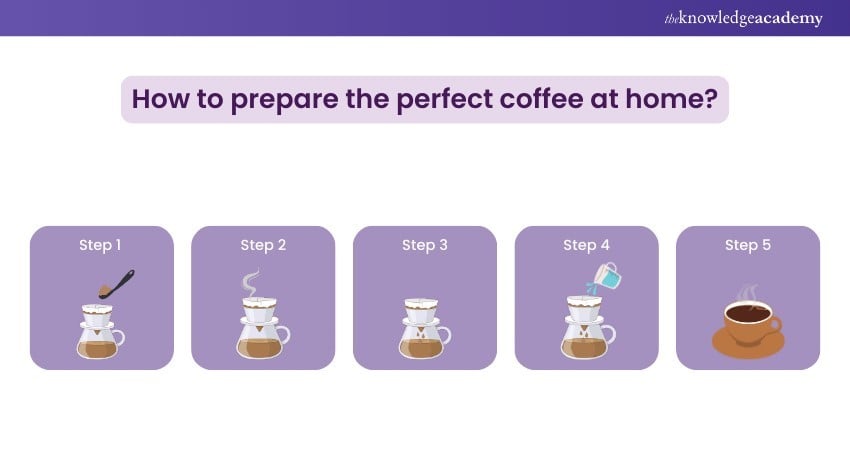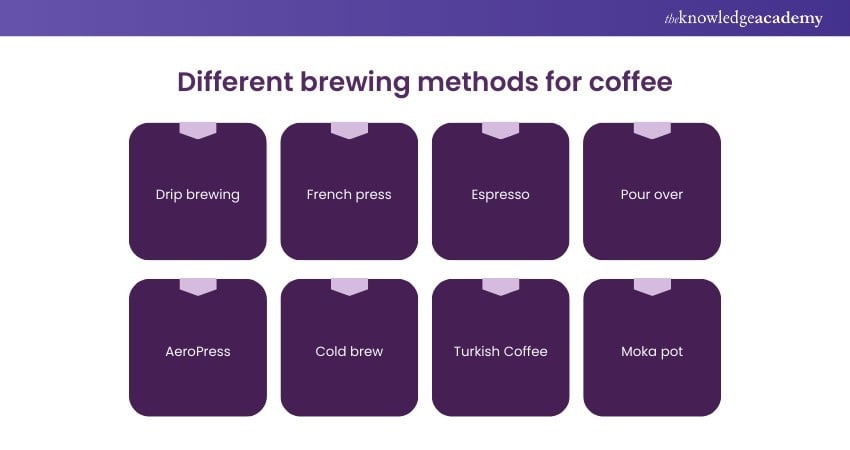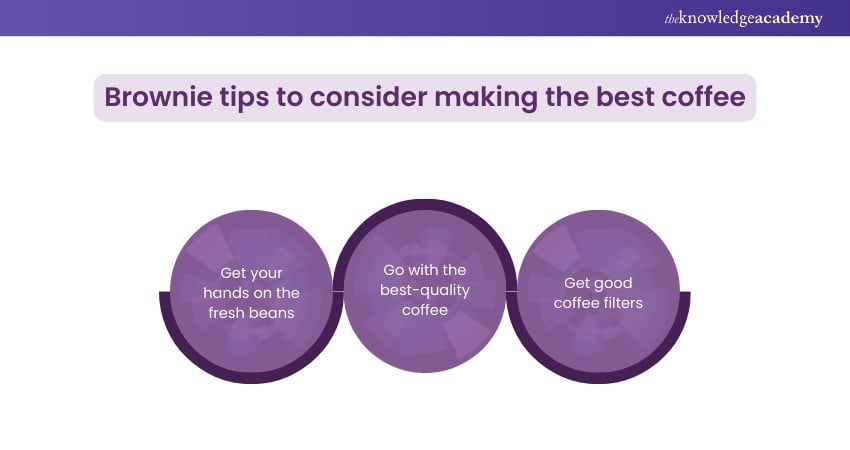We may not have the course you’re looking for. If you enquire or give us a call on +852 2592 5349 and speak to our training experts, we may still be able to help with your training requirements.
Training Outcomes Within Your Budget!
We ensure quality, budget-alignment, and timely delivery by our expert instructors.

Who doesn't want to wake up to the first sip of perfect coffee? It feels like paradise. Making a perfect cup of coffee isn't a piece of cake, as three components necessitate the brewing of a perfect cup of joe (coffee): If you want this perfect cup of coffee, you need to learn How to Make Coffee.
This process includes the perfect toast, the ideal water temperature, and your engagement. Preparing the coffee for its sake will yield only a small result. To get the most out of your coffee, give it some love while it's brewing!
This blog will discuss step-by-step procedure on How to Make Coffee, that will blow your mind. You will also find some essential brownie points that can add a difference to your coffee.
Table of Contents
1)How to Make Coffee?
2) How to prepare the perfect coffee at home?
3) Different brewing methods for coffee
4) Brownie tips to consider for making the best coffee
5) Conclusion
How to Make Coffee?
The way to brew the perfect cup of joe depends on how properly you have stored the beans and what filters you've used to keep bitterness at bay. Exploring various types of coffee can also play a crucial role in finding the brewing method that is suitable according to your taste preferences and enhances the overall coffee experience.
Besides, here are some other components that you should keep in mind to make the best cup of joe:
1) Get the right beans
If you want to make the perfect cup of coffee, you need to start with the base of it: The coffee beans. Getting your hands on good quality coffee beans is super important. Depending on the quality and the flavour of your coffee beans you can determine the brewing process. There are different factors which influence the flavour factors of the coffee:
a) The country of origin,
b) The different class of beans it belongs to: Arabica, robusta, or a blend
c) The type of roast that the beans get
d) The texture to which the beans are grinded.
2) Get the perfect toast
There's no hard-and-fast rule for when to drink roasted coffee. However, it's wise to go with fresh toast to yield better results. You should always question the quality of the roast and its preparation time. When you hunt to find the perfect roast, you will discover that some coffee has to be consumed within six days of its roast date, while some can be consumed for a month. Find the proper toast based on your requirements.
3) Get the right water temperature
The flavour of your coffee massively depends on the temperature of the water and to what extent you've agitated the coffee beans. If you add low-temperature water, you will observe that the coffee will turn more bitter.
On the contrary, if you use high-temperature water, you will observe that it results in better extraction from the beans. Also, it's essential to keep in mind the quality of the water. Make sure to use water that has relatively fewer minerals in it.
4) Get the right grind
There's no precise grind size to make a good cup of joe. The right grind always depends on your desire and preference. Besides, always ask yourself whether you want a caffeinated or sweetened cup. If you go with the finer grinds, you will have more coffee flavour than the coarse grind.
In addition, if you're using an old roast, make sure to use a finer grind to get the most out of the coffee flavour. If you're thinking of mixing the coffee grinds, be ready to derail your quest for the perfect cup. Also, it's better always to keep cleaning the grinder before accessing it to ensure no filth is left.
5) Get the right brewing time
Getting the right brewing type for different types of coffee beans is crucial to create the perfect brew for you. There are various brewing methods out of which these are quite popular:
a) In the drip method, the contact time of the beans and the water should be approximately five minutes
b) If you are using a French press to make your coffee, then the contact time should be between two-four minutes
c) If you are planning for an Espresso, you would require a very brief time. The coffee grind should be only 20-30 seconds be in contact with water.
d) If you want a cold brew, then to get the maximum flavour of the beans you need to soak the coffee grind in water for over 12 hours.
However, if you feel that you are still not happy with the final product then you may either have over-extracted or under-extracted your coffee grind.

How to prepare the perfect cup of coffee at home?

Before starting the coffee preparation, weigh the ground coffee to get a better result. Never measure it at random with measuring spoons, scoops, or cups. If you want to prepare 8 ounces of coffee, use around one tablespoon or around 15 grammes of ground coffee per ounce. You'll need about 60 grams, or four tablespoons of ground coffee, to make 4 cups.
Below are the ingredients and steps to make coffee:
Ingredients require to brew coffee
Make sure to get your hands on all of these three ingredients to get your perfect brew:
1) Get filtered water to get authentic flavour.
2) The ideal proportion of the coffee-water mixture should be two tablespoons of ground coffee per eight ounces of water. You can adjust the quantity of coffee grinds according to your taste.
3) There is no such thing as a perfect grind because it depends on the machine. The longer the grounds are in contact with water, the coarser the grind will get.
Steps to prepare the perfect brew
1) Place the filter around the basket of the coffee maker. Make sure to include medium-sized ground coffee beans. Add water to it.
2) Once the water gets filtered, bring it to a boil and let it sit for a minute.
3) Add sufficient water to the filter to ensure that it remains wet, and then let it drain into your cup. Later, remove the excess water.
4) Now measure the ground coffee present in the filter. Add enough water to wet the beans again, drain them into your cup, and then add the remaining water.
Join our renowned Train the Trainer course and gain the expertise you need to inspire and educate others effectively.
Different brewing methods for coffee

There are many different modes of making coffee each contributes its own distinct trait to the flavour, aroma, and body of the product. Let’s look at some different brewing methods for coffee:
a) Drip brewing: It means that the coffee is made by hot water that drips on coffee grounds that are held in a filter and then the brewed coffee slowly drips into a carafe or a pot. Machines can likewise have different capabilities of temperature and time settings.
b) French press: This method also called using a press pot, is achieved by allowing coarse coffee grounds to steep in hot water for some minutes, before separating the grounds from the water by plunging them away with a plunger. This leads to a robust and full flavour, since the coffee's natural oils and fine particles are not filtered out.
c) Espresso: This method uses a high-pressure espresso machine instead that forces hot water through very finely ground coffee. Thus, the coffee is a result of delicious and smooth shot of coffee with a layer of cream on top, which is commonly referred to as "crema". Espresso is the primary base of many coffee drinks like lattes and cappuccinos.
d) Pour over: This method involves making of coffee in brewing hot water over with the coffee grounds in a filter. The water drips through the coffee and filters into a carafe or a cup. The V60 or Chemex are some of the popular devices for this method, which allows to have the precise control over the brewing time and temperature.
e) AeroPress: The AeroPress is a rather new device, which can brew coffee through applying hot water under high pressure to the coffee grounds by pushing the plunger. This way is highly efficient, as it takes only about two minutes, and the final product is a smooth and rich tasting coffee.
f) Cold brew: For cold brew, coffee grounds are soaked in cold or room temperature water for a longer period, usually 12 to 24 hours. This mix yield is a concentrate that is less pungent and may be served over ice cubes or diluted with water or milk.
g) Turkish Coffee: In this method, the coffee beans ground finely and brewed in water (sometimes with sugar) until the served drink is ready. The grounds settle down in the cup which makes the coffee strong, unfiltered, and has a unique taste.
h) Moka pot: This method is also referred to as a stovetop espresso maker, which is the Moka pot produces espresso coffee by letting the hot water being pressurised by steam flow through the ground coffee. It's less concentrated/intense than an espresso but more robust than drip coffee made with water.
Brownie tips to consider making the best coffee

Here are a handful of tips that you can consider to make the best coffee:
1) Get your hands on the fresh beans
Undeniably, coffee is best when consumed within a few days of roasting. Either roast it yourself or buy it from a local vendor to get fresh beans. Always avoid buying the beans in bulk, as if it's exposed to bright light, they may destroy the coffee's flavour. Choose stores that sell fresh beans and are very concerned about quality. It's a safe bet to go with the coffee sellers who have packaged the beans well in a sealed bag and are pretty conscious of their quality.
2) Go with the best-quality coffee
A coffee connoisseur would always strive for the taste of coffee. To ensure that you have the perfect cup of joe at the start of the day, select a brand of coffee that mentions the region and country of origin. Most people either prefer Robusta or Arabica. Arabica beans are known to have a better flavour.
Make sure to get your hands on pure Arabica beans. Robusta beans are the best option if you're on a tight budget and want to avoid splurging! It has more caffeine content. If you're a barista and your budget is shoestring, but you want to ensure that you get the best quality beans, you can hit your nearby grocery store to explore some good brands that can be great alternatives to these gourmet beans for half the price!
3) Get good coffee filters
Don't use cheaper paper coffee filters, as they degrade the quality of the coffee. Instead, look for dioxin-free or oxygen-bleached filters. You can also use long-lasting gold-plated filters, as these paper filters are known to deliver the best flavours.
Conclusion
It’s not easy to make the perfect cup of coffee. We hope that you learnt How to Make Coffee, from this blog. This blog also discussed that you need to keep experimenting with the coffee roasts, grind sizes, and water temperature. Experiment enough until you find your "perfect cup of joe"! As you embark on this coffee-making journey, consider exploring variations like How To Make Hazelnut Coffee to add a touch of richness and nutty flavor to your brewing repertoire.
Sign up for our Industry Training Course to imbibe insights into coffee brewing, floristry and phone repairing!
Frequently Asked Questions

Start with fresh, medium-ground coffee. Use around 2 tablespoons for every 200 ml of water. Heat water almost to boiling. Soak the grounds in a drip maker or French press. Steep for 4-5 minutes (French press). Serve immediately.

The three layers of an espresso shot are the crema, body, and heart.

The Knowledge Academy takes global learning to new heights, offering over 30,000 online courses across 490+ locations in 220 countries. This expansive reach ensures accessibility and convenience for learners worldwide.
Alongside our diverse Online Course Catalogue, encompassing 17 major categories, we go the extra mile by providing a plethora of free educational Online Resources like News updates, Blogs, videos, webinars, and interview questions. Tailoring learning experiences further, professionals can maximise value with customisable Course Bundles of TKA.

The Knowledge Academy’s Knowledge Pass, a prepaid voucher, adds another layer of flexibility, allowing course bookings over a 12-month period. Join us on a journey where education knows no bounds.

The Knowledge Academy offers various Industry Courses including Basic Barista Course, Floristry Introduction Course and Facilities Management Course. These courses cater to different skill levels, providing comprehensive insights into the What is a Barista?
Our Business Skills Blogs cover a range of topics related to musical instruments, offering valuable resources, best practices, and industry insights. Whether you are a beginner or looking to advance your skills as a Barista, The Knowledge Academy's diverse courses and informative blogs have you covered.
Upcoming Business Skills Resources Batches & Dates
Date
 Basic Barista Course
Basic Barista Course
Fri 17th Jan 2025
Fri 7th Mar 2025
Fri 23rd May 2025
Fri 18th Jul 2025
Fri 12th Sep 2025
Fri 14th Nov 2025
Fri 12th Dec 2025







 Top Rated Course
Top Rated Course


 If you wish to make any changes to your course, please
If you wish to make any changes to your course, please


